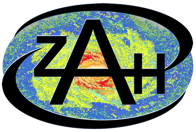My Research:
3. Star Cluster Systems
Preamble
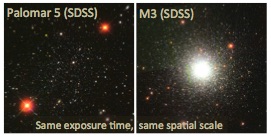 Star clusters cover a wide range of gravitationally bound stellar
agglomerates ranging from massive, compact, long-lived globular
clusters to low-mass, diffuse, short-lived associations, from
metal-poor objects to clusters with super-solar metallicity, and from
very old populations to embedded young clusters. It has been
suggested that all stars originally formed in clusters or asociations.
The study of the many types of clusters is worthwhile in its own right
and reveals important information on star formation processes and the
impact of galactic environment. A crucial advantage of star clusters
relative to field star populations is that they represent, to first
order, coeval populations and can be easily age-dated when they are
resolved into individual stars. Star clusters have been identified in
all galaxy types except for the least massive ones. As ensembles,
star clusters can serve as a very useful tracer of galaxian star
formation history.
Star clusters cover a wide range of gravitationally bound stellar
agglomerates ranging from massive, compact, long-lived globular
clusters to low-mass, diffuse, short-lived associations, from
metal-poor objects to clusters with super-solar metallicity, and from
very old populations to embedded young clusters. It has been
suggested that all stars originally formed in clusters or asociations.
The study of the many types of clusters is worthwhile in its own right
and reveals important information on star formation processes and the
impact of galactic environment. A crucial advantage of star clusters
relative to field star populations is that they represent, to first
order, coeval populations and can be easily age-dated when they are
resolved into individual stars. Star clusters have been identified in
all galaxy types except for the least massive ones. As ensembles,
star clusters can serve as a very useful tracer of galaxian star
formation history.
The work presented in this section was done with my past and present graduate students and postdocs Katharina Glatt, Andreas Koch, Geneviève Parmentier, Frederik Schönebeck, Fayezeh Shabani, and Carolin Wittmann.
Subtopics
- 3.1 Globular Cluster Systems of Massive Galaxies
- 3.2 Globular Clusters in Dwarf Galaxies
- 3.3 The Recent Star Formation History of the Magellanic Clouds from Star Clusters
- 3.4 Young Massive Clusters in Star-Forming Galaxies
3.1 Globular Cluster Systems of Massive Galaxies
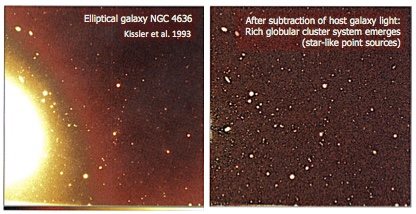 Massive elliptical galaxies
host the richest globular cluster systems, usually encompassing many
thousands of globular clusters. Rich globular cluster systems usually
show a shallower density distribution profile than the distribution of
the underlying host galaxy's light (e.g., Kissler et al. 1994). It is customary to
normalize the number of globular clusters by the absolute visual
brightness of their host galaxy, which yields the so-called specific
frequency of globular clusters as a quantitative and comparable
measure (Harris & van den Bergh 1981). Isolated
ellipticals tend to have lower specific frequencies than the very
massive elliptical galaxies in galaxy clusters. Globular cluster
systems tend to exhibit color bimodalities. It is believed that the
redder and more metal-rich globular clusters formed in situ, while the
bluer and probably more metal-poor globulars may have been accreted
from smaller galaxies.
Massive elliptical galaxies
host the richest globular cluster systems, usually encompassing many
thousands of globular clusters. Rich globular cluster systems usually
show a shallower density distribution profile than the distribution of
the underlying host galaxy's light (e.g., Kissler et al. 1994). It is customary to
normalize the number of globular clusters by the absolute visual
brightness of their host galaxy, which yields the so-called specific
frequency of globular clusters as a quantitative and comparable
measure (Harris & van den Bergh 1981). Isolated
ellipticals tend to have lower specific frequencies than the very
massive elliptical galaxies in galaxy clusters. Globular cluster
systems tend to exhibit color bimodalities. It is believed that the
redder and more metal-rich globular clusters formed in situ, while the
bluer and probably more metal-poor globulars may have been accreted
from smaller galaxies.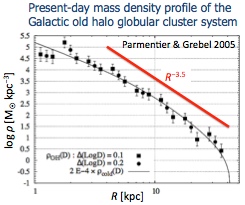 A dichotomy between globular clusters
formed in situ and accreted ones has also been suggested for disk
galaxies like our Milky Way: As my former postdoc Geneviève
Parmentier showed, the radial mass density profile of the old
halo globular cluster system may be a relic of the distribution of the
cold baryonic material in the protogalaxy. Beyond a Galactocentric
distance of 2 to 3 kpc, the initial shape of this mass density profile
is preserved, and even the flattening of this profile observed at
shorter Galactocentric radii may be in part of primordial origin (Parmentier & Grebel 2005). In contrast, the
so-called young halo globular clusters, which show a more
extended distribution, are believed to have been accreted.
A dichotomy between globular clusters
formed in situ and accreted ones has also been suggested for disk
galaxies like our Milky Way: As my former postdoc Geneviève
Parmentier showed, the radial mass density profile of the old
halo globular cluster system may be a relic of the distribution of the
cold baryonic material in the protogalaxy. Beyond a Galactocentric
distance of 2 to 3 kpc, the initial shape of this mass density profile
is preserved, and even the flattening of this profile observed at
shorter Galactocentric radii may be in part of primordial origin (Parmentier & Grebel 2005). In contrast, the
so-called young halo globular clusters, which show a more
extended distribution, are believed to have been accreted.
We found the elliptical galaxy NGC 1404 in the Fornax galaxy cluster to have a comparatively low globular cluster specific frequency. We interpreted this as well as its unsually high radial velocity and high X-ray luminosity as evidence for recent infall into the cluster (Richtler et al. 1992). Our kinematic studies of the globulars around the dominant elliptical in Fornax, NGC 1399, revealed that its red globular cluster system has a lower velocity dispersion than its blue globular clusters (Dirsch et al. 2004; Richtler et al. 2004). Globular clusters have repeatedly been used as dynamical tracers of the underlying galactic mass distribution. For NGC 1399, we found that its dark halo potential can be well-reproduced by a logarithmic potential or by a Navarro, Frenk, & White (1997) profile (Richtler et al. 2004). A wide-field imaging study of the central 0.5 square degrees of the Fornax cluster allowed us to investigate the large-scale distribution of globular clusters in this galaxy cluster (D'Abrusco et al. 2016). We found that the spatial distribution of the globular clusters connects NGC 1399 to its neighboring giant ellipticals, which may imply that NGC 1399 stripped globular clusters from its neighbors. Red globular clusters tend to be more spatially concentrated around the loci of the ellipticals and show relatively small-scale density structures possibly caused by galaxy-galaxy interactions. On the other hand, blue globulars show a much more spatially extended distribution and may have been removed from the halos of massive galaxies in the core of Fornax by this galaxy cluster's substantial gravitational potential (D'Abrusco et al. 2016).

3.2 Globular Clusters in Dwarf Galaxies
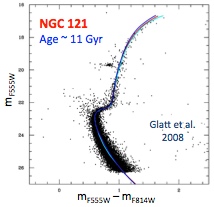 Only the more massive dwarf galaxies contain globular clusters. The
number of globular clusters tends to be small but owing to the low
absolute luminosities of the dwarfs the resulting specific frequencies
may be large (Grebel 2002, 2016). Only four of the Milky Way companions -
the Large Magellanic Cloud (LMC), the Small Magellanic Cloud (SMC),
and the dwarf spheroidal galaxies Fornax and Sagittarius contain
globular clusters. LMC, Fornax, and Sagittarius have globular
clusters that are as old as the oldest Galactic globulars (e.g., Grebel & Gallagher 2004). But as my graduate
student Katharina Glatt confirmed based on deep color-magnitude
diagrams obtained with the Hubble Space Telescope, the only globular
cluster in the SMC, NGC 121, is two to three Gyr younger than the
oldest Galactic globular clusters (Glatt et al. 2008). With its red horizontal
branch, the moderately metal-poor NGC 121 resembles the so-called
"young halo globular clusters". It is unclear why the SMC formed only
one surviving globular and why this happened a few Gyr later than in
the other nearby dwarf galaxies containing globular clusters.
Only the more massive dwarf galaxies contain globular clusters. The
number of globular clusters tends to be small but owing to the low
absolute luminosities of the dwarfs the resulting specific frequencies
may be large (Grebel 2002, 2016). Only four of the Milky Way companions -
the Large Magellanic Cloud (LMC), the Small Magellanic Cloud (SMC),
and the dwarf spheroidal galaxies Fornax and Sagittarius contain
globular clusters. LMC, Fornax, and Sagittarius have globular
clusters that are as old as the oldest Galactic globulars (e.g., Grebel & Gallagher 2004). But as my graduate
student Katharina Glatt confirmed based on deep color-magnitude
diagrams obtained with the Hubble Space Telescope, the only globular
cluster in the SMC, NGC 121, is two to three Gyr younger than the
oldest Galactic globular clusters (Glatt et al. 2008). With its red horizontal
branch, the moderately metal-poor NGC 121 resembles the so-called
"young halo globular clusters". It is unclear why the SMC formed only
one surviving globular and why this happened a few Gyr later than in
the other nearby dwarf galaxies containing globular clusters.
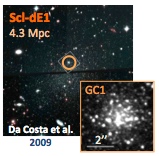 The half-light radii of globular clusters in the Milky Way
generally increase with Galactocentric distance although there is a
considerable amount of scatter (van den Bergh, Morbey, & Pazder 1991). The "vital diagram" of Gnedin & Ostriker (1997) suggests that extended
globular clusters would not survive at small Galactocentric radii.
Also globular clusters in the Large Magellanic Cloud show a tendency
of increasing sizes with increasing galactocentric distances (Hodge 1962). The mean half-light radii of
galactic globular cluster systems increase with decreasing galaxy
luminosity (Jordán et al. 2005). Dwarf galaxies
contain globular clusters with a range of half-light radii including
faint, extended globulars that resemble the properties of outer halo
globular clusters (van den Bergh & Mackey 2004). It has been
repeatedly suggested that the outer halo globular clusters where
primarily accreted from since disrupted dwarf galaxies. This holds in
particular for the so-called young halo globular clusters with their
predominantly red horizontal branches, although it is important to
remember that dwarf galaxies host globulars with the full range of
horizontal branch morphologies including second-parameter globular
clusters as well as with a variety of half-light radii (e.g., Grebel 2016).
The half-light radii of globular clusters in the Milky Way
generally increase with Galactocentric distance although there is a
considerable amount of scatter (van den Bergh, Morbey, & Pazder 1991). The "vital diagram" of Gnedin & Ostriker (1997) suggests that extended
globular clusters would not survive at small Galactocentric radii.
Also globular clusters in the Large Magellanic Cloud show a tendency
of increasing sizes with increasing galactocentric distances (Hodge 1962). The mean half-light radii of
galactic globular cluster systems increase with decreasing galaxy
luminosity (Jordán et al. 2005). Dwarf galaxies
contain globular clusters with a range of half-light radii including
faint, extended globulars that resemble the properties of outer halo
globular clusters (van den Bergh & Mackey 2004). It has been
repeatedly suggested that the outer halo globular clusters where
primarily accreted from since disrupted dwarf galaxies. This holds in
particular for the so-called young halo globular clusters with their
predominantly red horizontal branches, although it is important to
remember that dwarf galaxies host globulars with the full range of
horizontal branch morphologies including second-parameter globular
clusters as well as with a variety of half-light radii (e.g., Grebel 2016). We discovered one of the most extended globular clusters known in a dwarf galaxy in the dwarf elliptical Scl-dE1 in the Sculptor group (Da Costa et al. 2009). While luminous, compact globular clusters typically have half-light radii around 3 pc, this globular cluster Scl-dE1 GC1 has an effective radius of 22 pc. Evaluating the known half-light radii of globular clusters in dwarf galaxies, we find their distribution to be bimodal, including a substantial contribution from extended globular clusters. When considering data of globular clusters in massive galaxies (the Milky Way, M31, and Centaurus A) the fraction of globular clusters with small half-light radii strongly increases, but the overall distribution remains bimodal despite tidal effects that presumably destroyed many of the extended clusters that once formed at shorter galactocentric distances (see figure below; Da Costa et al. 2009). Due to this persistent dichotomy in half-light radii, we suggest that there may be two modes of globular cluster formation with the extended cluster mode (and the survival of such clusters) being more common in environments with lower tidal forces such as dwarf galaxies. In contrast, high-pressure environments such as massive galaxies form preferentially globular clusters with small effective radii (Da Costa et al. 2009).
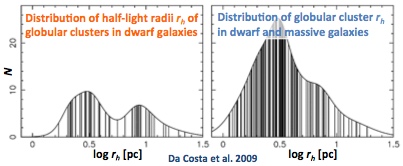
3.3 The Recent Star Formation History of the Magellanic Clouds from Star Clusters
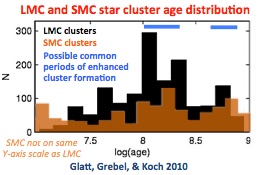 If star clusters cover a sufficiently wide range of ages and are
sufficiently numerous, they can be used as tracers of galactic star
formation histories. Unlike the Milky Way, the Magellanic Clouds host
a large number of massive, young, compact star clusters. In order to
differentiate them from the low-mass, loose open clusters commonly
found in the Milky Way as well as from old globular clusters, the term
"populous clusters" was introduced for this cluster type (Hodge 1961. Owing to their proximity, young
Magellanic Cloud clusters can easily be resolved into individual stars
via ground-based observations.
If star clusters cover a sufficiently wide range of ages and are
sufficiently numerous, they can be used as tracers of galactic star
formation histories. Unlike the Milky Way, the Magellanic Clouds host
a large number of massive, young, compact star clusters. In order to
differentiate them from the low-mass, loose open clusters commonly
found in the Milky Way as well as from old globular clusters, the term
"populous clusters" was introduced for this cluster type (Hodge 1961. Owing to their proximity, young
Magellanic Cloud clusters can easily be resolved into individual stars
via ground-based observations. In the framework of the Magellanic Clouds Photometric Survey (MCPS; Zaritsky et al. 2002, 2004), we carried out a multi-color CCD drift scan survey of the central 64 deg² of the Large Magellanic Cloud (LMC) and of the central 18 deg² of the Small Magellanic Cloud (SMC). Using the resulting point-source photometry catalogs, my graduate student Katharina Glatt age-dated 1193 populous star clusters in the LMC and 324 SMC clusters via isochrone fits to their resolved color-magnitude diagrams (Glatt, Grebel, & Koch 2010).
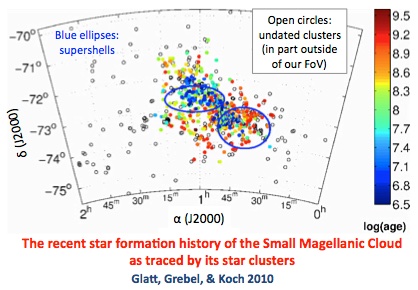 We found indications for two periods of enhanced star cluster
formation in both galaxies some 100 to 200 Myr and 600 to 800 Myr ago,
which may have been caused by past close encounters between the Clouds
and the Milky Way. Moreover, we obtained the spatially resolved
recent star formation history of both Clouds based on their young star
clusters. The youngest clusters reside in supergiant and giant
shells, in the compressed regions between two adjacent shells, and
toward regions with a high Hα content, suggesting that their
formation is related to shell expansion and shell-shell interaction.
Most of the clusters, however, are older than the dynamical age of the
supergiant shells (Glatt et al. 2010).
We found indications for two periods of enhanced star cluster
formation in both galaxies some 100 to 200 Myr and 600 to 800 Myr ago,
which may have been caused by past close encounters between the Clouds
and the Milky Way. Moreover, we obtained the spatially resolved
recent star formation history of both Clouds based on their young star
clusters. The youngest clusters reside in supergiant and giant
shells, in the compressed regions between two adjacent shells, and
toward regions with a high Hα content, suggesting that their
formation is related to shell expansion and shell-shell interaction.
Most of the clusters, however, are older than the dynamical age of the
supergiant shells (Glatt et al. 2010). In the SMC, clusters younger than about 15 Myr are located along the bar, particularly toward the eastern and western rims of the HI supershells 37A and 304A. Clusters with ages of about 16 to 60 Myr are still concentrated around the bar with some outliers in the SMC wing. In the age range of 60 to 300 Myr, clusters are seen throughout the main body and the northern part of the SMC. The oldest age-dated clusters with ages between 300 Myr to 1 Gyr populate mainly the western part of the SMC's main body (Glatt et al. 2010).
In the LMC, clusters younger than 20 Myr are mainly found in the 30 Doradus region, in supershells LMC 3, 4, 8 (especially along the rims), in many of the giant shells, and in the western part of the bar. For ages of 20 to 50 Myr, the star clusters are more widely distributed across 30 Dor, LMC 3, 4, 5, 8, and many giant shells. Also, they are scattered throughout the western part of the LMC and show an increased concentration along the western and central parts of the bar. In the age range of 50 to 100 Myr, the cluster distribution resembles a slightly tilted capital Greek Θ with a high concentration of clusters in the northeast and along most of the bar (except for its easternmost parts). For ages from 100 to 250 Myr the similarity to a tilted Θ persists, and star clusters now occupy the entire length of the bar. In the age range of 250 to 500 Myr, star clusters populate mostly the LMC bar, but many are also distributed along the western and northwestern LMC rim as well as in the northeast. 30 Dor and LMC 3 are now almost devoid of clusters, and very few are seen in LMC 4. At yet higher ages the concentration of clusters along the bar shows a pronounced decline (Glatt et al. 2010). These results demonstrate how massive star formation migrated with time across the disk and gradually propagated along the bar of the LMC.

We used a subset of 307 age-dated clusters with masses > 5000 M⊙ and ages > 10 Myr in order to investigate the cluster age distribution and dissolution rate in the LMC (Baumgardt et al. 2013). We found the frequency of massive clusters to be roughly constant between 10 and 200 Myr. In other words, there is no significant influence of cluster dissolution for clusters younger than about 200 Myr, since both the ratio of the number of clusters to the absolute field star formation rate and the cluster mass function are independent of time for these clusters.
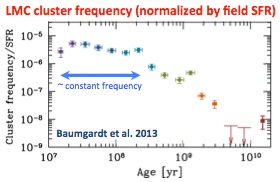 If residual gas expulsion is an important dissolution mechanism for
star clusters ("infant mortality"), its influence seems to be
restricted to the first 10 Myr of cluster evolution or to low-mass
clusters with masses below 5000 M⊙. Young star
clusters in the LMC form with a power-law mass function of slope
α = 2.3. Extrapolating this mass function down to 100
M⊙ and comparing it with the absolute star formation
rate indicates that about 15% of all stars in the LMC form in
bound star clusters that survive for at least 10 Myr (Baumgardt et al. 2013).
If residual gas expulsion is an important dissolution mechanism for
star clusters ("infant mortality"), its influence seems to be
restricted to the first 10 Myr of cluster evolution or to low-mass
clusters with masses below 5000 M⊙. Young star
clusters in the LMC form with a power-law mass function of slope
α = 2.3. Extrapolating this mass function down to 100
M⊙ and comparing it with the absolute star formation
rate indicates that about 15% of all stars in the LMC form in
bound star clusters that survive for at least 10 Myr (Baumgardt et al. 2013).
For ages older than 200 Myr, the cluster frequency starts to drop. The ratio of cluster frequency to star formation rate is approximately a factor of 40 smaller at 4 Gyr than what it was at 200 Myr. Also, the cluster mass function exhibits a much shallower slope for clusters older than 1 Gyr. The number of missing clusters in our catalog needed to explain this flattening seems to be too large to be explained by incompleteness, suggesting that most of the flattening is due to cluster dissolution. In fact, for ages higher than 200 Myr about 90% of all clusters are lost per dex of lifetime (Baumgardt et al. 2013).
3.4 Young Massive Clusters in Star-Forming Galaxies
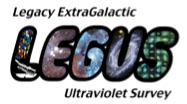 The Legacy ExtraGalactic Ultraviolet Survey (LEGUS) is a Hubble
Space Telescope Treasury Program that has imaged 50 star-forming
galaxies of different Hubble types within 12 Mpc in UV and optical
broadband filters (Calzetti et al. 2015a). A key data product of
LEGUS are catalogs of the numerous young star clusters in the target
galaxies as well as the physical characteristics of these clusters
(Adamo et al., in prep.). Apart from studies of the resolved massive
stellar populations, these unique data permit us to explore the young
star cluster systems as a function of environment and host galaxy
properties, to investigate the evolution of the clustering properties
of intense massive star formation in space and time, cluster mass
functions and their evolution, cluster dissolution time scales, and
more. The analysis of the LEGUS data is ongoing, involving my graduate
student Fayezeh Shabani. Below a few of the results are highlighted,
focussing on star clusters.
The Legacy ExtraGalactic Ultraviolet Survey (LEGUS) is a Hubble
Space Telescope Treasury Program that has imaged 50 star-forming
galaxies of different Hubble types within 12 Mpc in UV and optical
broadband filters (Calzetti et al. 2015a). A key data product of
LEGUS are catalogs of the numerous young star clusters in the target
galaxies as well as the physical characteristics of these clusters
(Adamo et al., in prep.). Apart from studies of the resolved massive
stellar populations, these unique data permit us to explore the young
star cluster systems as a function of environment and host galaxy
properties, to investigate the evolution of the clustering properties
of intense massive star formation in space and time, cluster mass
functions and their evolution, cluster dissolution time scales, and
more. The analysis of the LEGUS data is ongoing, involving my graduate
student Fayezeh Shabani. Below a few of the results are highlighted,
focussing on star clusters. 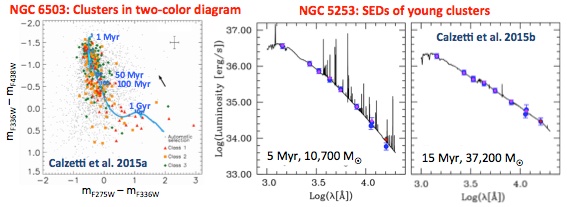 Thanks to the good wavelength coverage of the LEGUS HST data, the star
clusters identified in the images can be age-dated via two-color
diagrams and simple stellar population isochrones, via spectral energy
distribution (SED) fits, and more complex modeling of stellar and
nebular emission contributions, the stochastic sampling of the stellar
mass function, etc. (see Calzetti et al. 2015a, 2015b; Krumholz et al. 2015; Wofford et al. 2016; and Adamo et al., in prep.).
We found that applying different spectral synthesis models (from the
Auckland, Geneva, and Padova groups) on average only leads to small
differences in the resulting reddening, age, and mass. Models with
interacting binaries provide the best fits while models with single
rotating stars reproduce the SEDs less well (Wofford et al. 2016).
Thanks to the good wavelength coverage of the LEGUS HST data, the star
clusters identified in the images can be age-dated via two-color
diagrams and simple stellar population isochrones, via spectral energy
distribution (SED) fits, and more complex modeling of stellar and
nebular emission contributions, the stochastic sampling of the stellar
mass function, etc. (see Calzetti et al. 2015a, 2015b; Krumholz et al. 2015; Wofford et al. 2016; and Adamo et al., in prep.).
We found that applying different spectral synthesis models (from the
Auckland, Geneva, and Padova groups) on average only leads to small
differences in the resulting reddening, age, and mass. Models with
interacting binaries provide the best fits while models with single
rotating stars reproduce the SEDs less well (Wofford et al. 2016). In the star-forming spiral galaxy NGC 628 we used 1392 cluster candidates younger than approximately 100 Myr to study their clustering properties via a two-point correlation function analysis (Grasha et al. 2015). We found that the strength of the clustering decreases with both increasing spatial scale and increasing age. For clusters older than 40 Myr we observe a pronounced decrease of the clustering strength - these clusters are largely randomly distributed. In terms of spatial scales, clusters beyond a scale length of about 160 pc show a fairly homogeneous distribution. Clusters with centrally concentrated light profiles ("compact clusters") tend to have the highest masses and oldest ages and show little clustering across all spatial scales, whereas extended, asymmetrical clusters ("associations") include those with the lowest average masses and youngest ages. They show the steepest clustering slopes. Generally though the mass of the star clusters turns out to have little effect on the clustering strength; it is primarily governed by age. Overall, the hierarchy in stellar aggregate clustering resembles that of the turbulent interstellar medium (Grasha et al. 2015).
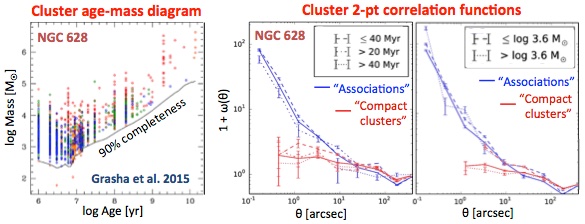
References
- Baumgardt, H., Parmentier, G., Anders, P., & Grebel, E.K. 2013, MNRAS, 430, 676
- Calzetti, D., Lee, J.C., Sabbi, E., Adamo, A., Smith, L.J., Andrews, J.E., Ubeda, L., Bright, S.N., Thilker, D., Aloisi, A., Brown, T.M., Chandar, R., Christian, C., Cignoni, M., Clayton, G.C., da Silva, R., de Mink, S., Dobbs, C., Elmegreen, B.G., Elmegreen, D.M., Evans, A.S., Fumagalli, M., Gallagher, J.S., Gouliermis, D.A., Grebel, E.K., et al. 2015a, AJ, 149, 51
- Calzetti, D., Johnson, K.E., Adamo, A., Gallagher, J.S., Andrews, J.E., Smith, L.J., Clayton, G.C., Lee, J.C., Sabbi, E., Ubeda, L., Kim, H., Ryon, J.E., Thilker, D., Bright, S.N., Zackrisson, E., Kennicutt, R.C., de Mink, S.E., Whitmore, B.C., Aloisi, A., Chandar, R., Cignoni, M., Cook, D., Dale, D.A., Elmegreen, B.G., Elmegreen, D.M., Evans, A.S., Fumagalli, M., Gouliermi, D.A., Grasha, K., Grebel, E.K., et al. 2015b, ApJ, 811, 75
- Da Costa, G.S., Grebel, E.K., Jerjen, H., Rejkuba, M., & Sharina, M.E. 2009, AJ, 137, 4361
- D'Abrusco, R., Cantiello, M., Paolillo, M., Pota, V., Napolitano, N.R., Limatola, L., Spavone, M., Grado, A., Iodice, E., Capaccioli, M., Peletier, R., Longo, G., Hilker, M., Mieske, S., Grebel, E.K., Lisker, T., Wittmann, C., van de Ven, G., & Fabbiano, G. 2016, ApJL, 819, L31
- Dirsch, B., Richtler, T., Geisler, D., Gebhardt, K., Hilker, M., Alonso, M.V., Forte, J.C., Grebel, E.K., Infante, L., Larsen, S., Minniti, D., & Rejkuba, M. 2004, AJ, 127, 2114
- Glatt, K., Gallagher, J.S., Grebel, E.K., Sabbi, E., Sirianni, M., Clementini, G., Tosi, M., Harbeck, D., Koch, A., & Cracraft, M. 2008, AJ, 135, 1106
- Glatt, K., Grebel, E.K., & Koch, A. 2010, A&A, 517, A50
- Gnedin, O.Y., & Ostriker, J.P. 1997, ApJ, 474, 223
- Grasha, K., Calzetti, D., Adamo, A., Kim, H., Elmegreen, B.G., Gouliermis, D.A., Aloisi, A., Bright, S.N., Christian, C., Cignoni, M., Dale, D.A., Dobbs, C., Elmegreen, D.M., Fumagalli, M., Gallagher, J.S., Grebel, E.K., et al. 2015, ApJ, 815, 93
- Grebel, E.K. 2002, in Extragalactic Star Clusters, IAU Symp. 207, eds. D. Geisler, E.K. Grebel, & D. Minniti (ASP: San Francisco), p. 94
- Grebel, E.K. 2016, in Star Clusters and Black Holes in Galaxies across Cosmic Time, IAU Symp. 312, eds. Y. Meiron, S. Li, F.-K. Liu, & R. Spurzem (CUP: Cambridge), p. 157
- Grebel, E.K., & Gallagher, J.S. 2004, ApJL, 610, L89
- Harris, W.E., & van den Bergh 1981, AJ, 86, 1627
- Hodge, P.W. 1961, ApJ, 133, 413
- Hodge, P.W. 1962, PASP, 74, 248
- Jordán, A., et al. 2005, ApJ, 634, 1002
- Kissler, M., Richtler, T., Held, E.V., Grebel, E.K., Wagner, S.J., & Capaccioli, M. 1994, A&A, 287, 463
- Krumholz, M.R., Adamo, A., Fumagalli, M., et al. 2015, ApJ, 812, 147
- Parmentier, G., & Grebel, E.K. 2005, MNRAS, 359, 615
- Richtler, T., Grebel, E.K., Domgörgen, H., Hilker, M., & Kissler, M. 1992, A&A, 264, 25
- Richtler, T., Dirsch, B., Gebhardt, K., Geisler, D., Hilker, M., Alsonso, M.V., Forte, J.C., Grebel, E.K., Infante, L., Larsen, S., Minniti, D., & Rejkuba, M. 2004, AJ, 127, 2094
- van den Bergh, S., & Mackey, A.D. 2004, MNRAS, 345, 713
- van den Bergh, S., Morbey, C., & Pazder J. 1991, ApJ, 375, 594
- Wofford, A., Charlot, S., Bruzual, G., Eldridge, J.J., Calzetti, D., Adamo, A., Cignoni, M., de Mink, S.E., Gouliermis, D., Grasha, K., Grebel, E.K., et al. 2016, MNRAS, 457, 4296
- Zaritsky, D., Harris, J., Thompson, I.B., Grebel, E.K., & Massey, P. 2002, AJ, 123, 855
- Zaritsky, D., Harris, J., Thompson, I.B., & Grebel, E.K. 2004, AJ, 128, 1606
Back to research overview
